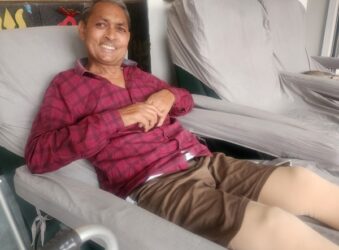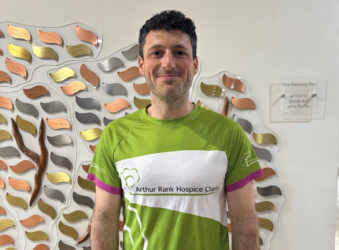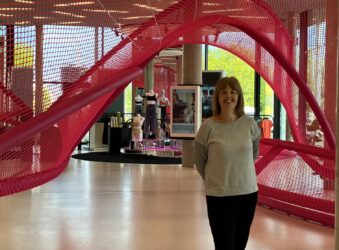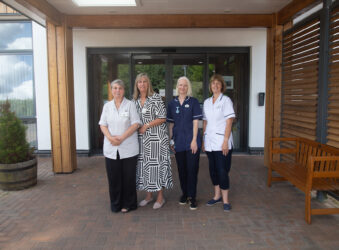Video consultations for Lymphoedema Outpatients
Share this story
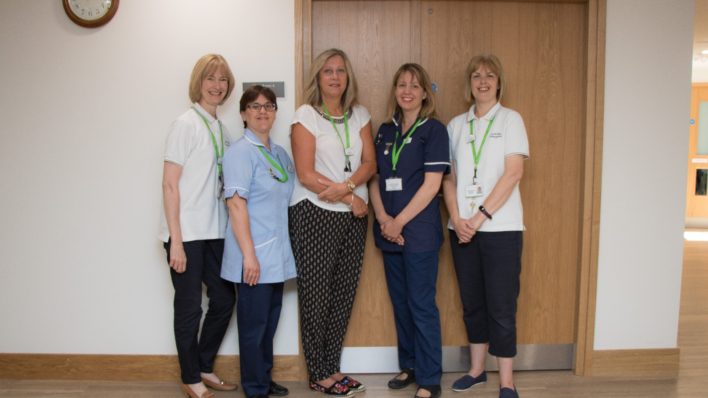
Did you know that Arthur Rank Hospice Charity supports hundreds of outpatients each year through our Lymphoedema Clinic? In the last quarter of 2020 alone (October to December) they supported 205 outpatients through 251 appointments.
An Unexpected Chapter – silver linings from the pandemic: video consultations for Lymphoedema outpatients
What is Lymphoedema?
A chronic long-term swelling caused when the lymphatic system fails, either due to genetic fault (primary lymphoedema) or through damage from infection, injury, deep vein thrombosis or treatment such as radiotherapy or surgery for cancer (secondary lymphoedema). Unfortunately, it cannot be cured, but with appropriate treatment it can be controlled and often significantly improved.
How can it be treated?
The team focus on best management and encouraging patients to take on-going control of their condition, designing programmes tailored to the individual. This might involve compression hosiery, exercise, self-lymphatic drainage, skin care, kinesiology tape, low level light therapy or the use of a compression pump.
All outpatients previously visited the Hospice
Our dedicated specialist team, based at the Hospice in the Bradbury Wellness Centre, have continued to support their patients throughout the pandemic. However, over the last 12 months other ways to assess and support patients have been introduced.
Before the pandemic, all consultations would have initially taken place in person, at the Hospice, most taking an hour or more, to diagnose, treat or provide specialist advice on someone’s condition. This would have meant a patient would have had to leave their home, access or arrange transport and navigate traffic around the City. Instead, during the pandemic the Hospice tried to do what it could to minimise such potential risks.
As an example of how this has impacted in-person appointments, between October and December – of 251 appointments – 62% were face-to-face, 32% took place over the telephone and 6% took place via video calls.
Using video for consultations
Since June 2020, where necessary and possible, the team have used video as a new method for assessments and appointments, via an NHS secure system called accuRx
The team recently shared a couple of real-life examples with us as about how this has helped them carry on delivering support where it has been needed– with impressive results!
Mary*
Mary completed a course of 30 radiotherapy sessions for cancer on her tonsil, between March and June 2020. As a result of the treatment she was experiencing secondary lymphodema of the neck.
She was referred to the Lymphoedema team , and they were able to carry out a video assessment the very next day. She reported problems with swallowing in the night which often took some time to clear in the morning and that she “didn’t like her turkey neck”, which she hadn’t had before. Her aim and primary motivation was to improve her swallowing and the shape of her neck.
Upon examining her over the secure accuRx video system the team could see that she had some swelling and internal oedema but that her skin – despite looking thickened – was intact.
Thanks to the video image, there were able to advise her there and then on an initial treatment plan. This involved skin care, head and neck exercises, positioning advice for sleeping more upright at night with an angled bed rest, self-massage to help with drainage of the lymphatic system They also sent her some Kinesiology Therapeutic tape (used to reduce swelling, increase mobility and enhance recovery) for a patch test, along with a leaflet about the Lymphoedema Support Network, that day.
Follow up face-to-face
After this first video appointment, the specialist clinician organised a face-to-face follow up that took place in September.
Mary reported that she was now sleeping in a more upright position, doing the recommended exercises and using self-massage to help drain away the fluid.
Having conducted an examination, the clinician identified that there was a thickening of tissue between the top and bottom of the neck and throat. She added a stress ball to the regime (along with a diagram) to help assist the lymphatic self-massage. A demonstration was also given of how to go about this and within 10 minutes of showing her how to do this, they could see improved results, with the tissue softening.
As Mary had no reaction to the Kinesiology tape patch test, so she was shown how to tape her neck in the right place to help with further drainage. A photograph was taken so she has a record of how to do reapply this at a future point: although she lives alone, she had a neighbour who she can ask to help her with his.
Video check-in, January
Having arranged to speak again over video consultation, Mary reported that her swallowing has improved a lot, now she is sleeping more upright. She has been doing exercises twice a day and the clinician added a soft collar to add some resistance to her exercises. The clinician asked her to demonstrate her application of the Kinesiology tape and method for self-lymphatic drainage massage and both were being done correctly.
Making a real difference
Wonderfully, Mary’s oedema is now not only softening, but also reducing and she has the tools she needs to self-manage her condition, meaning she could be discharged.
Previously, before video consultations were used, Mary would have had three and a half hours of face-to-face appointments and all the travel back and forth that this would have required. Instead, the team was able to achieve the same results with one face to face appointment and two video appointments using the accuRx secure NHS system.
John*
John was diagnosed with bladder cancer in March 2018. He received radiotherapy and was all-clear until Summer 2020 when he developed a left leg swelling – which was the first sign that the cancer had reoccurred. He underwent further radiotherapy and was referred to Lymphoedema in September.
Video assessment instead of cancellation
John’s initial appointment with our Lymphoedema team was due to be face-to-face in September 2020. However, a COVID-19 screening test carried out prior to assessment, showed he was suffering from a cold and was very fatigued. It was therefore decided that his assessment would instead be done over video using the NHS accuRx system. His daughter helped set things up, and he gave his consent for her to be present.
John reported that his leg swelling had improved slightly since the course of radiotherapy, with the tissues seeming softer. He said that there was swelling from his toes to his groin but not extending to the other side. The clinician could see that John appeared pale and fatigued and was resting on the sofa with his leg elevated.
He reported that he was tired because of his cold and the recent radiotherapy treatment. He explained how he was usually a very active, independent man, moving without assistance throughout his house and garden, and up and down the stairs, managing all his own self-care.
Advice to ‘get started’
Our clinician explained to him about secondary lymphoedema and directed him to the ‘What is Lymphoedema’ video hosted on the Hospice’s website which explains more about how it is related to disease. He was also given advice about skincare and exercises, explaining that there were some helpful videos – also on the Hospice’s website – which he could follow. Leaflets with further information were sent on in the post.
Thanks to his daughter being present, the team were able to get measurements for his leg so they could source a compression garment for him. He was provided with advice on how this could be safely used. It was agreed that his next appointment should be face-to-face, allowing the clinician to measure his leg more fully and see the hosiery in situ.
Six weeks later
John came into the Bradbury Wellness Centre in November for his face-to-face appointment with the Lymphodema team as scheduled. He had been able to carry on with all the advised exercises, skin care routine, leg elevation and was wearing his compression hosiery, which he could manage independently.
Both he and his daughter were very grateful that they had been given the ‘advice to get started’ over video and his leg was much improved and reduced in size.
Making a real difference
The team plan to review the situation again via video consultation in five months, when his compression garment will be replaced, or before if he felt necessary. Previously John’s appointment would have had to have been cancelled, but thanks to the secure accuRx system our team were instead able to intervene at a critical point, with positive impact.
We think it is safe to say that for people like Mary John and our Lymphodema team, the introduction of video consultations (kickstarted by the advent of COVID-19) has been a progressive and positive step forward. Just one silver lining we will continue to develop long after the pandemic’s lockdowns are over.
*Patient names have been changed
Read ‘An Unexpected Chapter – Inpatient Unit’
Read ‘An Unexpected Chapter – Day Therapy’
Read ‘An Unexpected Chapter – The Patient and Family Support Team’
Read ‘An Unexpected Chapter for our Director of Fundraising and Communications’
View other stories
-

Hospice Charity support Lymphoedema Patients in India
Compression stockings were donated to India
-

Hospice Patient gives back by running the London Marathon
Brad Morris shares his journey from the Lymphoedema Clinic to the London Marathon!
-

Lymphoedema Lead visits compression hosiery factory in Germany
Tracy Hancock shares her learnings from her visit to a compression hosiery factory
-

Lymphoedema Team ‘Step a Million’ for Charity
Tracy and Natasha take part in Step a Million and encourage their patients to be as mobile as possible

